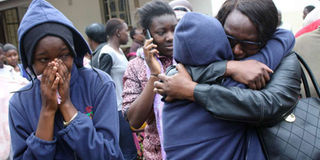Premium
Many students die as disaster report gathers dust

Relatives and students at Moi Girls School, Nairobi, in shock after eight girls died and many others were injured in a dormitory fire on September 2, 2017. PHOTO | ANTHONY OMUYA| NATION MEDIA GROUP
What you need to know:
It also observed only a few schools had fire-fighting equipment.
In most schools visited, there were no fire assembly points
The report pointed out that most schools did not have the necessary safety policy.
The report raised concerns over narrow doors that compromised the safety of students.
Education expert Andiwo Obondo raised concerns about the response and preparedness of learning institutions to handle disasters.
The death of eight students at Moi Girls School Nairobi on Saturday has once again put into sharp focus the safety of students in boarding schools.
The incident comes four months after a government led taskforce recommended drastic measures to ensure the safety of students in schools but whose implementation still remains unclear.
The report on unrest in learning institutions last year that was released in May pointed out that dormitories in most schools had no emergency exits or had blocked emergency.
It also observed only a few schools had fire-fighting equipment.
“Some had empty fire extinguishers cans while others were placed in inappropriate places where they were of no use during fire emergency. In most schools visited, there were no fire assembly points,” said the report that was compiled by a special investigation team which was led by former provincial administrator Claire Omollo.
Ms Omollo and her team had recommended that the ministry of Education establish a monitoring and evaluation section to enforce compliance with policies and ensure accountability by school management within six months.
SAFETY POLICY
The report pointed out that most schools did not have the necessary safety policy.
“The inadequate preparation for fire disasters had led to inability to salvage student’s school property leading to loses even in cases where such loses could have been prevented.
“The evidence of unpreparedness could have been a reason for students’ use of arson to express their grievances and to force the administration to allow them to go home. This situation was found to be risky to the lives of students in the event of fire outbreak,” noted the report.
It also raised concerns over narrow doors that compromised the safety of students.
“Most of the schools visited had overcrowded and congested dormitories with some students sleeping on triple decker beds in order to accommodate larger numbers and in some cases students were forced to share beds,” said the report.
It was also reported that some dormitories were sometimes locked from outside when students were a sleep to deter them from sneaking out of the school compounds at night.
“In other cases, the keys of the dormitories were kept by students or watchmen contrary to the safety regulations which stipulated that keys be in the custody dormitory masters or mistresses or dormitory prefects,” added the report.
According to the safety standards manual details, dormitories should have double doors, opening outwards and windows must be without grills.
WELL VENTILATED
Dormitories must also be clean and well ventilated and spaces between beds must be wide enough to allow for manoeuvre and space during emergency.
The team recommended that all boarding schools should be re-inspected to ensure basic standards for boarding are met and those that do not meet the basic standards should be registered or converted to day schools.

A student of Sigoti Complex Girls secondary school in Kisumu County scours through what remained of her property after two dormitories in the school were burnt down on September 2, 2017. PHOTO | TONNY OMONDI |NATION MEDIA GROUP
“Schools should adopt appropriate security measures including perimeter fencing and 24-hour manning, CCTV surveillance, fire extinguisher, sniffer dog checks, metal detectors, random dog security patrols, adequate security lighting, engage vetted security guards and create awareness on security matters,” recommended the report.
It also recommended fire drills for students and staff at least twice a year, an issue that was to be implemented within six months after the presentation of the report to Education cabinet Secretary.
Schools were also advised to have functional, well maintained and strategically placed fire-fighting equipment’s. Within a year, schools were also advised to adopt appropriate security measures including; perimeter fencing and 24-hour manning, CCTV surveillance, fire extinguisher, sniffer dog checks, metal detectors, random dog security patrols, adequate security lighting, engaging vetted security guards and creating awareness on security matters.
It also recommended the implementation of the recommendations parts of Wangai and Koech task forces report with were partially
SECURITY GUARDS
Schools were also advised to employ adequate vetted security guards with security skills and who are not beyond the mandatory retirement age.
The report also pointed at the presence of terrorists and criminal gangs in schools with teachers sharing extremist literature with students with the aim of radicalising them.
It is not the first time lives have been lost in schools.
In 1991, 19 girls at St Kizito Mixed secondary school died from rape by boys and suffocation while in 1998, 26 girls died at Bombolulu girls Secondary school in a dormitory fire.
In 1999, four prefects at Nyeri High school died when they were locked in their cubicle by other students and set on fire while at Kyanguli secondary school in 2001, 68 boys died in a dormitory fire.
In 2008, one student died at Upper Hill secondary school died in a dormitory fire while in 2015 two students at Steph Joy a private school in Kiambu County died and 10 others were injured in a dormitory fire.
UNREST
Last year, there were a total of 483 incidents of unrest which included 239 cases of fire and 244 other forms of unrest with 429 cases being reported in second term with 1,075 suspects being arrested of which 1,029 were students while 46 were non-students.
On Saturday, Kenya National Union of Teachers (Knut) Secretary-General Wilson Sossion demanded a thorough investigation into the Saturday’s fire at Moi Girls secondary School in Nairobi.
“We are demanding Kenyans be told the truth. The police should do so with the urgency that it deserves,” said Mr Sossion adding the death of the students was painful and should not recur in any other learning institution.
Education expert Andiwo Obondo raised concerns about the response and preparedness of learning institutions to handle disasters.
“We must change the way we respond to disasters to avert more deaths. Hard questions must be asked on how the students died in the school and where the management was,” said Mr Obondo.
The Teachers Service Commission (TSC) Chief executive officer Nancy Macharia said she had learnt with sorrow the death the students.
“I take this opportunity to condole with parents and relatives of the girls the Board of Management (BOM), teachers and the entire school community following the tragic incident,” said Mrs Macharia and wished students who sustained injuries quick recovery.





